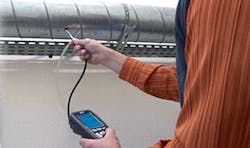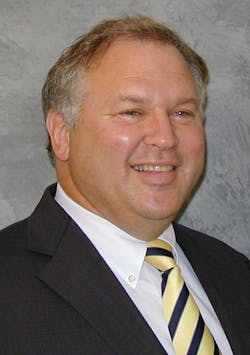The BTUs your mechanical equipment and system delivers is the ultimate measure of energy efficiency. This test is quick and relatively simple, and can help your your customers to easily understand the meaning of a system producing 50% of its rated BTUs before and 90% of the rated BTUs after you have upgraded and optimized the performance of their system.
The Pieces of the BTU Puzzle
Whether measuring heating or cooling BTUs, there are two measurements and an appropriate BTU multiplier that must be considered each time you measure. First is Airflow. Air is the medium that moves BTUs through a forced-air HVAC system. When measuring equipment BTUs, you’ll need to determine fan airflow. This is done by measuring the total external static pressure of the equipment, then determining the fan speed setting on residential or fan RPM on commercial equipment.
Next, plot fan airflow on the manufacturer’s fan tables provided with each piece of air moving equipment. This is accomplished by intersecting where the fan speed and the measured total external static pressure meet on the fan table.
When measuring system delivered BTUs, the airflow measurement is taken by reading the airflow from each supply register in the system and then adding the airflows together to identify the total airflow entering the building.
Second is Temperature Change. This is evidence of the work done by the system. Temperature change over a piece of air moving equipment is measured by the difference in the air temperature of the air entering and the air leaving the equipment.
Care must be taken when reading the discharge temperature of the equipment so that the temperature measurement probe does not “see” the hot or cold surfaces of the equipment, or the reading will be inaccurate.
Also, when measuring BTUs, be sure to record temperature to the nearest tenth of a degree. In heating mode, temperature is measured and recorded as a dry bulb value, in cooling mode; temperature is measured as a wet bulb value.
The third step: select the BTU multiplier. To calculate BTUs in heating mode, take the airflow times the dry bulb temperature change times the BTU multiplier of 1.08.
The 1.08 is the sensible BTU multiplier at sea level and is based on the weight of standard air (.075 lbs. of air per cfm) x .24 (The specific heat of air) x 60 (minutes in an hour) This multiplier needs to be adjusted for air density at higher elevations and also for extreme temperatures above or below 70F.
To calculate BTUs in when measuring a system in cooling mode, multiply the airflow times the enthalpy change times the cooling BTU multiplier of 4.5.
Enthalpy change is found by measuring the wet bulb temperatures in and out of the system and then converting to an equivalent enthalpy value (Click here to receive a procedure and table to help you do this.)
The cooling BTU multiplier of 4.5 equals .075 lbs. of air per cfm x 60 (minutes in an hour). This factor will also decrease at higher altitudes.
A Heating BTU Calculation Example
Suppose you are measuring the BTUs of a gas furnace. You plot the fan airflow at 870 CFM, the air temperature into the furnace is 67F and the air temperature downstream of the furnace is 107F. Subtract to find a temperature change of 40F. The heating BTU multiplier is 1.08. Here’s the math:
870 CFM x 40F x 1.08 = 37,584 BTU.
Compare the delivered BTUs of 37,584 that you just calculated to the furnace rated output of 54,000. Divide 37,584 BTU by 54,000 to find the furnace is only delivering 69% of its rated output.
So what if your furnace at home was operating this poorly? This translates to high energy costs and less comfort.
A Cooling BTU Calculation Example
Next, say you are measuring the BTUs of a 3-ton forced-air direct expansion cooling system. You measure each of the supply registers and add them together to find 905 CFM entering the building. Then measure the average wet bulb air temperature entering the return grilles at 61.6F. Using and enthalpy chart, convert 61.6F Wet Bulb to 27.55 BTU per lb. of air.
Next, measure the average supply register Wet Bulb Temperature at 54.1F. Convert to enthalpy to find 22.68 BTU per lb. of air. Subtract the supply enthalpy of 22.68 from the return enthalpy of 27.55 to find an enthalpy change of 4.87. The cooling BTU multiplier is 4.5. Here’s the cooling BTU math:
905 CFM x 4.87 BTU per lb. x 4.5 = 19,833 Total System BTUs.
Compare the delivered Cooling BTUs you just calculated of 19,833 to the 3-ton system rated BTUs of 36,000 to find your cooling system is only delivering 55% of the cooling system’s rated BTUs.
So, how well was the last system you serviced or installed really working?
The challenge is laid out before you. If you would really like to know how well your systems are operating, measure the equipment and system delivered BTUs. If not, just remain on the path you’re on and keep on hoping you’re doing a great job.
Rob “Doc” Falke serves the industry as president of National Comfort Institute (NCI) — an HVAC-based training company and membership organization. If you're an HVAC contractor or technician interested in a free Wet Bulb to Enthalpy Conversion Chart contact Doc at [email protected] or call him at 800-633-7058. Go to NCI’s website for free information, articles, and downloads.
About the Author
Rob 'Doc' Falke
President
Rob “Doc” Falke serves the industry as president of National Comfort Institute an HVAC-based training company and membership organization. If you're an HVAC contractor or technician interested in a building pressure measurement procedure, contact Doc at [email protected] or call him at 800-633-7058. Go to NCI’s website at NationalComfortInstitute.com for free information, articles and downloads.

